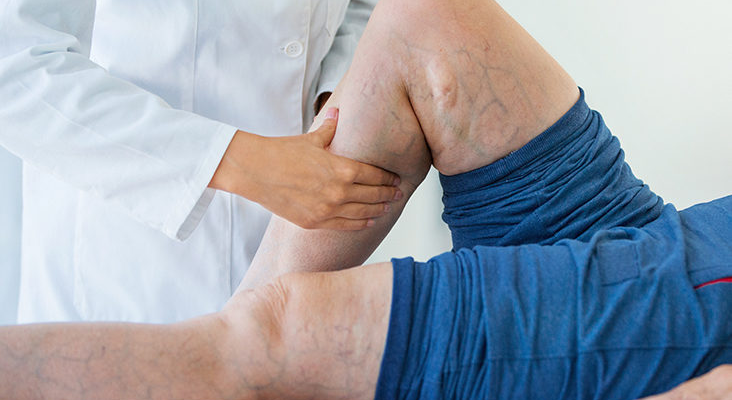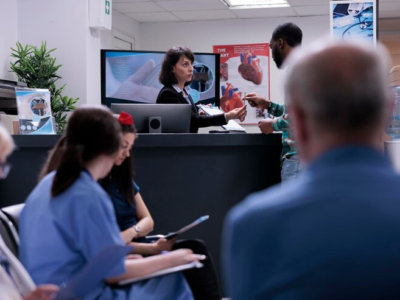Venous thromboembolic disease is a set of disorders encompassing deep vein thrombosis (DVT), pulmonary embolism and post-thrombotic syndrome.
When a vessel breaks, the hemostasis system allows blood to circulate through the vessels and prevents its flow to the outside, stopping bleeding by creating a thrombus limited to vascular injury.
Venous thrombosis is the occupation of the veins by a thrombus. If it is large and settles in the deep veins of the legs (deep vein thrombosis), small pieces can break off and block blood flow in the lungs when they ascend, leading to pulmonary embolism.
Also, the thrombosed vein dilates over time, and the blood stagnates. The leg increases in size, and the skin can become ulcerated. This skin acquires a bluish colour with a tendency to swell. This process is called post-thrombotic syndrome.
Causes
Risk factors that can cause thrombophilia include age, trauma and surgery, prolonged periods of immobilisation, oral contraceptives, hormone replacement therapy, pregnancy, obesity, heart and cancer disease, and antiphospholipid antibodies.
Genetic risk factors include antithrombin deficiency or lack of proteins C and S.
Although advances in the genetic aspects of thrombophilia are highly relevant, when the risk of thrombosis is assessed, only acquired factors and the patient’s physiological characteristics are usually taken into account, leaving genetic information to one side.
Symptoms
Pain in deep vein thrombosis in the thighs is the most frequent symptom; however, this pain is imprecise as it is spontaneous and with variable intensity depending on the subject.
Other characteristics are usually redness and an increase in the size of the leg or thigh.
Pulmonary embolism is characterised by chest pain, cough (sometimes with blood), and the sudden feeling of shortness of breath.
Prevention
Different clinical situations have a very high risk of developing the venous thromboembolic disease (VTE).
In most cases, pharmacological prevention is effective, especially in post-surgical patients, but it is advisable to consult a specialist before establishing prevention.
Early detection, drinking plenty of water, and contracting your calf muscles are other highly effective measures.
The groups most at risk are:
- Those with a history of VTE: Patients with a VTE are at risk of developing new episodes.
- Surgery: Prolonged immobilisation due to surgical causes increases the chances of VTE. The patient’s age, the type of surgery and the duration of the intervention are some factors that increase the risk.
- Cancer and VTE are closely related.
- Estrogens: In situations such as pregnancy, estrogen levels increase and favour the development of VTE, significantly if it is associated with surgery ( cesarean section ).
- Patients who must remain immobilised in bed for a long time.
Types
Currently, there is no classification of this disease.
Diagnosis
Given the suspicion of deep vein thrombosis, doctors recommend performing a Doppler ultrasound to visualise the venous system.
Suppose the pathology cannot be diagnosed with ultrasound. In that case, phlebography (a method that introduces contrast inside the vein that is only carried out in exceptional situations since it can have complications) will be studied.
In cases of suspected pulmonary embolism, the most common technique is to perform scintigraphy (introducing a radioactive contrast into the vein).
The test is safe, but the diagnosis of pulmonary embolism is not assured.
Treatments
Anticoagulant drugs are used to treat venous thromboembolic disease to regularise the thrombus and prevent fragmentation.
In cases of deep vein thrombosis, the doctor tries to prevent a pulmonary embolism from occurring, and in situations of pulmonary embolism, they prevent its progression.
Doctors use two types of anticoagulants:
- Oral: This treatment with anticoagulants, such as acenocoumarol, takes several days, so it is not used at the beginning of therapy because an immediate anticoagulant effect is required.
- Injectables: The treatment of choice is intravenous heparin. They act immediately but require frequent analytical controls, so patients must be hospitalised.
Low molecular weight heparins (LMWH) are currently being used. They are more comfortable since they are injected into the subcutaneous tissue and do not imply analytical controls or hospital admission. Therefore, the patient himself administers it.
What is thrombophilia?
Thrombophilia tends to develop thrombosis in the veins and arteries. It is a complex disease in which several factors intervene, such as blood pressure, blood flow, the coagulation process, inflammation and atherogenesis.
Thrombophilias can be inherited, acquired, or transient and can strongly or weakly influence the development of thrombosis.
Of preventable diseases, venous thromboembolism is the leading cause of death in hospitalised patients and is also the third most common vascular disease, behind heart disease and stroke.








Comments